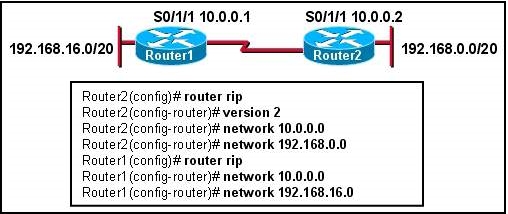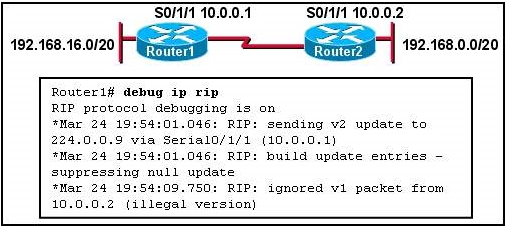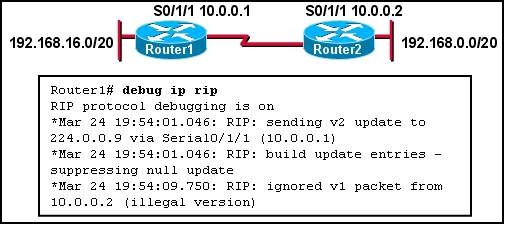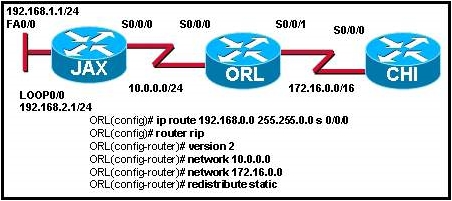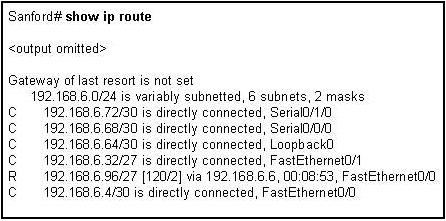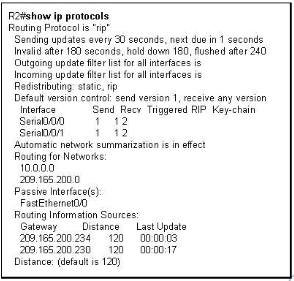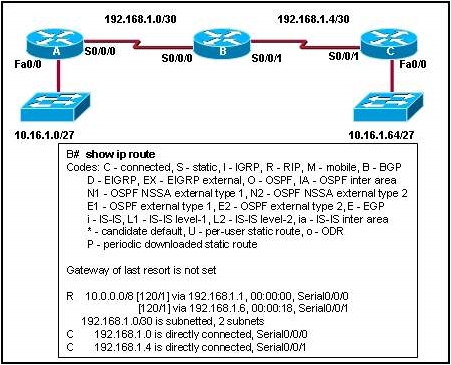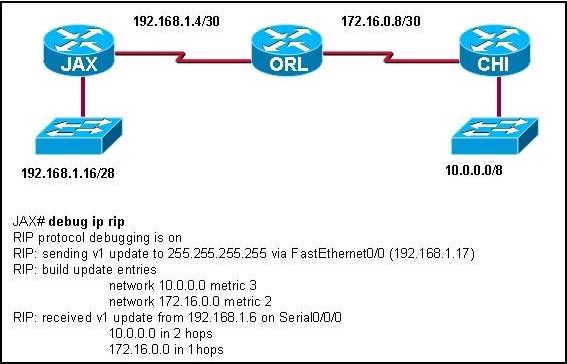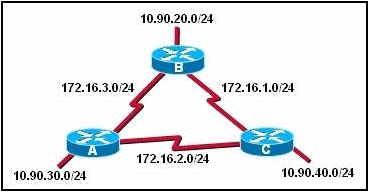CCNA: Routing Protocols And Concepts: Chapter 7
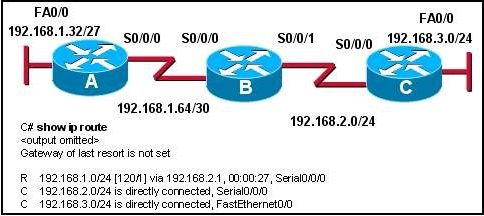
In today’s quiz on the CCNA program, we aim to test your knowledge on a host of different routing protocols, their concepts and various uses. We’ll be offering you a number of examples and expecting you to make the right moves! Let’s see how many you can get right.
- 1.
Refer to the exhibit. If all routers are running RIP version 2, why is there no route for the 192.168.1.32/27 network?
- A.
Rip version 2 does not send subnet masks in its updates.
- B.
Router A is not setup with RIP as a routing protocol.
- C.
Rip version 2 will auto summarize routes by default.
- D.
Router B is not setup to advertise the 192.168.1.64/30 network.
Correct Answer
C. Rip version 2 will auto summarize routes by default.Explanation
RIP version 2 will auto summarize routes by default. This means that when RIP version 2 advertises routes, it will automatically summarize them at the classful network boundary. In this case, the network 192.168.1.32/27 falls within the classful network 192.168.1.0/24. Since RIP version 2 auto summarizes routes, it will not advertise the more specific network 192.168.1.32/27, resulting in no route for that network in the routing table.Rate this question:
-
- 2.
Refer to the exhibit. Which two statements are true? (Choose two.)
- A.
Router1 will install a route to 192.168.0.0/20
- B.
Router1 will install a route to 192.168.0.0/24
- C.
Router1 will install a route to 192.168.16.0/24
- D.
Router2 will install a route to 192.168.16.0/24
- E.
Router2 will not install a route to 192.168.16.0/20
Correct Answer(s)
A. Router1 will install a route to 192.168.0.0/20
E. Router2 will not install a route to 192.168.16.0/20Explanation
Based on the exhibit, Router1 will install a route to 192.168.0.0/20 because it has a directly connected interface in that network. However, Router1 will not install a route to 192.168.0.0/24 because it does not have a directly connected interface in that network. Router1 will also install a route to 192.168.16.0/24 because it has a directly connected interface in that network. On the other hand, Router2 will not install a route to 192.168.16.0/20 because it does not have a directly connected interface in that network.Rate this question:
-
- 3.
Refer to the exhibit. Which command on which router will allow Router1 to learn about the 192.168.0.0/20 network?
- A.
Router1(config)# ip classless
- B.
Router1(config-router)# no passive-interface serial 0/1/1
- C.
Router2(config-router)# version 2
- D.
Router2(config-router)# neighbor 10.0.0.2
Correct Answer
C. Router2(config-router)# version 2Explanation
The command "Router2(config-router)# version 2" will allow Router1 to learn about the 192.168.0.0/20 network. This command is used to specify the version of the routing protocol being used. By setting it to version 2, Router2 is indicating that it is using a newer version of the routing protocol which may include updates or improvements that Router1 needs to be aware of in order to learn about the 192.168.0.0/20 network.Rate this question:
-
- 4.
What are two reasons to implement RIP version 2 rather than RIP version 1? (Choose two.)
- A.
RIP version 2 supports VLSM.
- B.
RIP version 2 supports more than 16 routers.
- C.
RIP version 2 supports classful (and not classless) routing
- D.
RIP version 2 supports routing update authentication.
- E.
RIP version 2 supports multi-areas.
Correct Answer(s)
A. RIP version 2 supports VLSM.
D. RIP version 2 supports routing update authentication.Explanation
RIP version 2 supports VLSM, which stands for Variable Length Subnet Masking. This allows for more efficient use of IP addresses by allowing the use of different subnet mask lengths within a network. RIP version 2 also supports routing update authentication, which provides a level of security by allowing routers to verify the authenticity of routing updates received from neighboring routers.Rate this question:
-
- 5.
How are RIP v1 and RIP v2 similar to one another? (Choose three.)
- A.
They both use hop count as a metric.
- B.
They both have the same metric value for infinite distance.
- C.
They both broadcast their updates to their neighbors.
- D.
They both send subnet mask information in their updates.
- E.
They both use split horizon to prevent routing loops.
Correct Answer(s)
A. They both use hop count as a metric.
B. They both have the same metric value for infinite distance.
E. They both use split horizon to prevent routing loops.Explanation
RIP v1 and RIP v2 are similar to one another in three ways. Firstly, they both use hop count as a metric to determine the distance between networks. Secondly, they both have the same metric value for infinite distance, meaning that if a network is unreachable, it is assigned the maximum metric value. Lastly, they both utilize split horizon, a technique that prevents routing loops by not advertising routes back to the same interface from which they were learned.Rate this question:
-
- 6.
Refer to the exhibit. Routers East and West are configured using RIPv1. Both routers are sending updates about their directly connected routes. The East router can ping the West router serial interface and West can ping the serial interface of East. However, neither router has dynamically learned routes from the other. What is most likely the problem?
- A.
A gateway of last resort is required.
- B.
Subnetting is not supported by RIPv1.
- C.
VLSM is not supported by RIPv1.
- D.
One of the routers needs a clock rate on the serial interface.
Correct Answer
C. VLSM is not supported by RIPv1.Explanation
RIPv1 does not support Variable Length Subnet Masking (VLSM), which allows for the use of different subnet masks within a network. This means that RIPv1 can only advertise routes using the default subnet mask for the network, which may cause issues when trying to communicate between routers with different subnet masks. In this scenario, both routers can ping each other's serial interfaces, indicating that the physical connectivity is fine. However, since they are not dynamically learning routes from each other, it suggests that the problem lies with the lack of support for VLSM in RIPv1.Rate this question:
-
- 7.
Refer to the exhibit. Which command will allow Router2 to learn about the 192.168.16.0/28 network?
- A.
Router1(config)# ip classless
- B.
Router1(config-router)# network 192.168.16.0
- C.
Router1(config-router)# no passive-interface serial 0/1/1
- D.
Router2(config-router)# version 2
- E.
Router2(config-router)# neighbor 10.0.0.2
Correct Answer
B. Router1(config-router)# network 192.168.16.0Explanation
The command "Router1(config-router)# network 192.168.16.0" is the correct answer because it allows Router1 to advertise the 192.168.16.0/28 network to its neighbors. This command tells the router to include the specified network in its routing updates, allowing Router2 to learn about it.Rate this question:
-
- 8.
Refer to the exhibit. All routers are running RIP version 2. JAX is configured to just advertise the 10.0.0.0/24 network. CHI is configured to advertise the 172.16.0.0/16 network. A network administrator enters the commands shown in the exhibit. What changes will occur in this network?
- A.
The JAX router will ignore updates for the 172.16.0.0/16 network due to split horizon issues.
- B.
The CHI router will install a route to the 192.168.0.0/16 network in its routing table.
- C.
The routing table for CHI will have the 192.168.0.0/16 route but it will have an S next to the route.
- D.
The ORL router will apply a 255.255.0.0 subnet mask to all networks in the routing updates it forwards.
Correct Answer
B. The CHI router will install a route to the 192.168.0.0/16 network in its routing table.Explanation
The CHI router will install a route to the 192.168.0.0/16 network in its routing table. This is because the command "network 192.168.0.0" is entered in the RIP configuration of the CHI router. This command tells the router to advertise the specified network in its routing updates. Therefore, the CHI router will include the 192.168.0.0/16 network in its routing table.Rate this question:
-
- 9.
Refer to the exhibit. A technician needs to add a new loopback interface to test routing functionality and network design. The technician enters the following set of commands on the router: Sanford(config)# interface loopback1 Sanford(config-if)# ip address 192.168.6.62 255.255.255.252 Why does the router respond with an error?
- A.
The router does not allow loopback interface configurations.
- B.
This mask can not be used with this class of addresses.
- C.
Classless routing must be configured before this address can be added.
- D.
The network address for Loopback1 overlaps with an already configured interface address.
- E.
The router is over the limit for the maximum paths that can be provided in the routing table.
Correct Answer
D. The network address for Loopback1 overlaps with an already configured interface address.Explanation
The router responds with an error because the network address for Loopback1 overlaps with an already configured interface address. This means that the IP address 192.168.6.62 is already being used by another interface on the router, and therefore cannot be assigned to the loopback interface. It is important to use unique IP addresses for each interface to avoid conflicts and ensure proper network functionality.Rate this question:
-
- 10.
What is the maximum network diameter permitted by the default metric of RIPv2?
- A.
15 hops
- B.
16 hops
- C.
100 hops
- D.
120 hops
- E.
255 hops
Correct Answer
A. 15 hopsExplanation
The maximum network diameter permitted by the default metric of RIPv2 is 15 hops. This means that RIPv2 will not consider routes that are more than 15 hops away as valid paths to reach a destination network. The metric is used to determine the best path for routing packets, and a hop refers to each time a packet is passed from one network device to another. Therefore, any routes that require more than 15 hops will be considered unreachable by RIPv2.Rate this question:
-
- 11.
What are two functions of the network command used when configuring routing protocols? (Choose two.)
- A.
Identifies which networks will be included in the routing updates
- B.
Identifies the hosts addresses that can be summarized in the network
- C.
Used to list all addresses for remote and local networks
- D.
Determines which subnet mask to apply to routing updates
- E.
Determines which interfaces can send and receive routing updates
Correct Answer(s)
A. Identifies which networks will be included in the routing updates
E. Determines which interfaces can send and receive routing updatesExplanation
The network command is used to identify which networks will be included in the routing updates. It allows the administrator to specify which networks should be advertised to other routers in the network. Additionally, the network command determines which interfaces can send and receive routing updates. This helps control the flow of routing information and ensures that only the desired interfaces participate in the routing process.Rate this question:
-
- 12.
Refer to the exhibit. What can be concluded from the output shown in the exhibit?
- A.
The routing table is limited to 2 routes.
- B.
The LAN interfaces are participating in the routing process.
- C.
One update has been sent out of each serial interface and 2 have been received.
- D.
The no auto-summary has not been configured on this router.
Correct Answer
D. The no auto-summary has not been configured on this router.Explanation
The output in the exhibit suggests that the "no auto-summary" command has not been configured on the router. This command is used to disable automatic summarization of routes at network boundaries. Since this command has not been configured, it indicates that the router is performing automatic summarization, which can lead to less efficient routing and potential routing issues.Rate this question:
-
- 13.
A network administrator has been told that the company IP address infrastructure must adhere to RFC 1918. What three IP address ranges from RFC 1918 could the administrator use on the network? (Choose three.)
- A.
10.0.0.0/8
- B.
127.0.0.0/8
- C.
169.254.0.0/16
- D.
172.16.0.0/12
- E.
192.168.0.0/16
Correct Answer(s)
A. 10.0.0.0/8
D. 172.16.0.0/12
E. 192.168.0.0/16Explanation
The network administrator can use the IP address ranges 10.0.0.0/8, 172.16.0.0/12, and 192.168.0.0/16 from RFC 1918. These ranges are reserved for private networks and are not routable on the internet. Using these IP address ranges ensures that the company's internal network is secure and isolated from the public internet.Rate this question:
-
- 14.
Refer to the exhibit. All routers are running RIPv1. What changes will occur in the routing table of router B if a loopback interface with an address of 10.16.1.129/27 is configured on router B?
- A.
Routes to the 10.16.1.0/27, 10.16.1.64/27, and 10.16.1.128/27 networks are added.
- B.
A connected route to the 10.16.1.128/27 network is added.
- C.
A third route to the 10.0.0.0/8 network with RIPv1 as the source is added.
- D.
The 10.0.0.0/8 route is dropped immediately from the routing table after router B is configured.
Correct Answer
B. A connected route to the 10.16.1.128/27 network is added.Explanation
When a loopback interface with an address of 10.16.1.129/27 is configured on router B, a connected route to the 10.16.1.128/27 network will be added to the routing table of router B. This means that router B will now have a direct connection to the 10.16.1.128/27 network, allowing it to send and receive traffic to and from that network without needing to go through any other routers.Rate this question:
-
- 15.
A network administrator installed four new routers that are running RIPv2. Router1 is a boundary router in the RIPv2 network and has a default route configured. Once the network has converged, the network administrator enters Router1(config-router)# defaultinformation originate on Router1. How will this affect the network?
- A.
Prevents Router1 from forwarding updates about networks that are not directly connected
- B.
Causes all routers in the network to synchronize routing updates with Router1
- C.
Forces Router1 to become the primary or designated router (DR) for updates
- D.
Propagates the default route to all routers in the network
Correct Answer
D. Propagates the default route to all routers in the networkExplanation
When the network administrator enters the command "default-information originate" on Router1, it will propagate the default route to all routers in the network. This means that all routers in the network will be aware of the default route and can use it to forward traffic to destinations that are not directly connected. This command is useful when there is a need for a default route to be advertised throughout the network, ensuring that all routers have a route to forward traffic to unknown destinations.Rate this question:
-
- 16.
Refer to the exhibit. The exhibited network contains a mixture of Cisco and non-Cisco routers. The command debug ip rip was entered on the JAX router. All routers are running the same version of RIP. Router CHI and Router ORL are not able to reach the 192.168.1.16/28 network. What is a possible solution to this problem?
- A.
Enable split horizon in the network.
- B.
Configure RIPv2 on routers.
- C.
Add network 192.168.1.0 to the RIP configuration on the JAX router.
- D.
Configure JAX Fa0/0 as a passive interface.
- E.
Enable the Serial0/0/0 interface on the JAX router.
Correct Answer
B. Configure RIPv2 on routers.Explanation
The possible solution to the problem of Router CHI and Router ORL not being able to reach the 192.168.1.16/28 network is to configure RIPv2 on the routers. This is because RIPv2 is an enhanced version of RIP that supports classless routing and can advertise subnet masks along with network addresses. By configuring RIPv2 on the routers, the 192.168.1.16/28 network will be included in the routing updates and properly advertised to Router CHI and Router ORL, allowing them to reach the network.Rate this question:
-
- 17.
What field was added to the RIP message header by RFC 1723 to add support for VLSM and CIDR?
- A.
Subnet mask
- B.
Destination port number
- C.
Address family identifier
- D.
Source and destination IP addresses
Correct Answer
A. Subnet maskExplanation
The field that was added to the RIP message header by RFC 1723 to add support for VLSM and CIDR is the subnet mask. The subnet mask is used to determine which part of an IP address represents the network address and which part represents the host address. By including the subnet mask in the RIP message header, routers are able to accurately determine the network prefixes and perform routing accordingly, supporting Variable Length Subnet Masks (VLSM) and Classless Inter-Domain Routing (CIDR).Rate this question:
-
- 18.
Refer to the exhibit. What effect will the commands that are shown have on RIP updates for Router1?
- A.
Only version 2 updates are sent to 255.255.255.255.
- B.
Only version 2 updates are sent to 224.0.0.9.
- C.
Both version 1 and version 2 updates are sent to 224.0.0.9.
- D.
Both version 1 and version 2 updates are sent to 255.255.255.255.
Correct Answer
B. Only version 2 updates are sent to 224.0.0.9.Explanation
The given commands configure Router1 to send only version 2 updates to the multicast address 224.0.0.9. This means that Router1 will only send RIP version 2 updates to its neighboring routers that are listening to the multicast address 224.0.0.9. It will not send any updates to the broadcast address 255.255.255.255 and it will not send any version 1 updates.Rate this question:
-
- 19.
Refer to the exhibit. RIPv1 is configured as the routing protocol for the network that is shown. The following commands are used on each router: router rip network 10.0.0.0 network 172.16.0.0 When this configuration is complete, users on the LAN of each router are unable to access the remote LANs. Why?
- A.
The network statements are configured incorrectly.
- B.
A routing loop has been created.
- C.
RIPv1 is unable to route to discontiguous subnets of a major network.
- D.
RIPv1 is unable to route networks with a /24 subnet mask.
Correct Answer
C. RIPv1 is unable to route to discontiguous subnets of a major network.Explanation
The users on the LAN of each router are unable to access the remote LANs because RIPv1 is unable to route to discontiguous subnets of a major network. This means that RIPv1 cannot route traffic between networks that are not directly connected and have different subnets within the same major network. In this case, the network statements are configured correctly, but RIPv1 is unable to handle the routing for the discontiguous subnets.Rate this question:
-
- 20.
RIPv2 is the configured routing protocol on the routers in a network. The command Router(config-router)# no version 2 is entered on the routers. What effect does entering this command have on routing updates?
- A.
Subnet masks will be added to the routing updates.
- B.
Routing updates will be sent out using multicast address 224.0.0.9.
- C.
Version 1 and 2 updates will be received and the version 2 updates will not be sent.
- D.
The RIP routing process will be removed from the router and routing updates will not be forwarded.
Correct Answer
C. Version 1 and 2 updates will be received and the version 2 updates will not be sent.Explanation
Entering the command "no version 2" on the routers will cause the routers to receive both version 1 and version 2 updates, but it will not send out version 2 updates. This means that the routers will be able to understand and process both versions of the updates, but they will only send out version 1 updates.Rate this question:
-
Quiz Review Timeline +
Our quizzes are rigorously reviewed, monitored and continuously updated by our expert board to maintain accuracy, relevance, and timeliness.
-
Current Version
-
Mar 21, 2023Quiz Edited by
ProProfs Editorial Team -
Nov 15, 2009Quiz Created by
Rodney.butler
 Back to top
Back to top



